Chiefdom of Lijiang
The Chiefdom of Lijiang (simplified Chinese: 丽江土司; traditional Chinese: 麗江土司; pinyin: Lìjiāng tǔsī) was a Nakhi autonomous Tusi chiefdom that ruled Lijiang during Yuan, Ming and Qing dynasty.
Chiefdom of Lijiang 麗江土司 | |||||||||
|---|---|---|---|---|---|---|---|---|---|
| ?–1723 | |||||||||
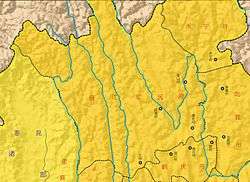 | |||||||||
| Status | Native Chiefdom of China | ||||||||
| Capital | Lijiang | ||||||||
| Common languages | Naxi language | ||||||||
| Government | Monarchy | ||||||||
| Jang Sadam Gyalpo | |||||||||
• ?–? | A-ts'ung A-liang (first) | ||||||||
• ?–1390 | Mu De | ||||||||
• 1597–1623 | Mu Zeng | ||||||||
• 1722–1723 | Mu Zhong (last) | ||||||||
| History | |||||||||
• Established | ? | ||||||||
• Disestablished | 1723 | ||||||||
| |||||||||
| Today part of | |||||||||
| UNESCO World Heritage Site | |
|---|---|
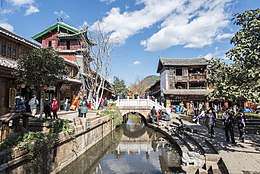 | |
| Location | Lijiang, Yunnan, China |
| Criteria | Cultural: (ii), (iv), (v) |
| Reference | 811bis |
| Inscription | 1997 (21st session) |
| Extensions | 2012 |
| Area | 145.6 ha (360 acres) |
| Buffer zone | 582.3 ha (1,439 acres) |
| Coordinates | 26°52′N 100°14′E |
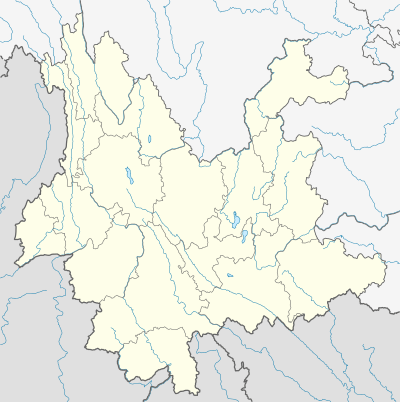 Location of Chiefdom of Lijiang in Yunnan 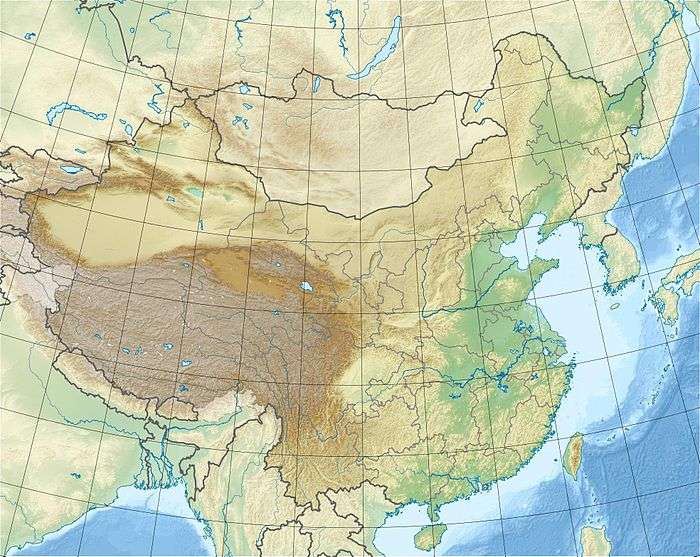 Chiefdom of Lijiang (China) | |
History
At first, Lijiang was ruled by Yuexi Zhao (越巂詔). Later, it was annexed by Nanzhao. According to legend, ancestor Lijiang chieftains was a Mongol.
Mongolian invaded Dali in 1253. Mou-pao A-ts'ung (牟保阿琮), the chieftain of Lijiang, surrendered to Mongol Empire. His son was granted the title Lijiang Lu Xuanweishi (麗江路宣慰使) by Yuan dynasty.
After Ming dynasty came into power, the chieftain A-chia A-te swore allegiance to Ming dynasty. Hongwu Emperor gave him the Chinese name "Mu De" (木得). From then on, chieftain of Lijiang also had Chinese name; they started to use Chinese surname Mu (木). They received the official position "Magistrate of Lijiang" (麗江知府) from Chinese emperor.
Chieftains of Lijiang helped Ming China in Ming conquest of Yunnan and Luchuan–Pingmian campaigns. They also seized many territories from neighbouring chiefdoms.
Lijiang saw its golden age during Mu Zeng's reign; It became the most powerful in present-day southwestern China. Lijiang attacked Gyalrong people frequently, and invaded Kingdom of Chakla. King of Chakla had to appeal for China's help. However, Mu Zeng promised to Chinese that he would offer soldiers in Ming–Manchu War. It was a successful diplomatic effort, Ming China did nothing but send an envoy to Lijiang to call for a cease-fire.
After Manchu conquest of China, chieftain Mu Yi (木懿) swore allegiance to Manchu Qing dynasty. In 1673, Wu Sangui revolted against Qing dynasty. Mu Yi rejected to swear allegiance to Wu Sangui, and was thrown into prison. Mu Yi was released after the rebellion was put down, and restored.
The Chiefdom of Lijiang was abolished by Yongzheng Emperor in 1723. Since then, the magistrates of Lijiang were all Han Chinese; they were appointed by Chinese emperor directly. The leader of Mu family was granted the title Tǔ Tōngpàn (土通判) from Chinese court, but had no real power.
Culture
Lijiang culture was deeply influenced by both Chinese and Tibetan culture. Nakhi people accepted Confucianism. Many chieftains were well educated. Mu Tai (木泰), Mu Gong (木公), Mu Gao (木高), Mu Qing (木青), Mu Zeng (木增) and Mu Jing (木靖) were good at writing Chinese poetry.
In 1639, Xu Xiake, a Chinese travel writer, came to Lijiang. Xu was warmly welcomed by Mu Zeng.[1]
Many Nakhi people also accepted the Tibetan Buddhism. Chieftain Mu Zeng provided shelter for Chöying Dorje, 10th Karmapa.
Old Town of Lijiang was registered on the UNESCO World Heritage List on December 4, 1997.[2]
List of Lijiang chieftains
| Portrait | Nakhi name | Chinese name | Reign | Notes |
|---|---|---|---|---|
 | A-ts'ung A-liang 阿琮阿良 | ?–? | ||
 | A-liang A-hu 阿良阿胡 | ?–? | ||
 | A-hu A-lieh 阿胡阿烈 | ?–? | ||
 | A-lieh A-chia 阿烈阿甲 | ?–? | ||
.jpg) | A-chia A-te 阿甲阿得 | Mu De 木得 | ?–1390 | started to use the surname "Mu" |
 | A-te A-ch'u 阿得阿初 | Mu Chu 木初 | 1390–1416 | |
 | A-ch'u A-t'u 阿初阿土 | Mu Tu 木土 | 1416–1433 | |
 | A-t'u A-ti 阿土阿地 | Mu Sen 木森 | 1433–1442 | |
 | A-ti A-hsi 阿地阿習 | Mu Qin 木嶔 | 1442–1485 | |
 | A-hsi A-ya 阿習阿牙 | Mu Tai 木泰 | 1485–1502 | |
 | A-ya A-ch'iu 阿牙阿秋 | Mu Ding 木定 | 1502–1526 | |
 | A-ch'iu A-kung 阿秋阿公 | Mu Gong 木公 | 1526–1553 | |
 | A-kung A-mu 阿公阿目 | Mu Gao 木高 | 1553–1568 | |
 | A-mu A-tu 阿目阿都 | Mu Dong 木東 | 1568–1579 | |
 | A-tu A-sheng 阿都阿勝 | Mu Wang 木旺 | 1579–1596 | |
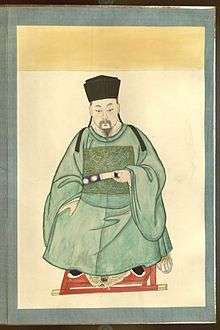 | A-sheng A-chai 阿勝阿宅 | Mu Qing 木青 | 1596–1597 | |
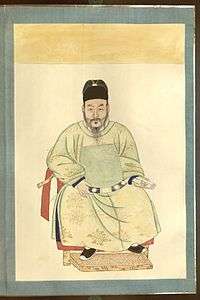 | A-chai A-ssu 阿宅阿寺 | Mu Zeng 木增 | 1597–1623 | |
 | A-ssu A-ch'un 阿寺阿春 | Mu Yi 木懿 | 1623–1669 | |
| A-ch'un A-su 阿春阿俗 | Mu Jing 木靖 | 1669–1671 | ||
 | Mu You 木櫾 | 1671–1680 | ||
 | A-su A-wei 阿俗阿胃 | Mu Yao 木堯 | 1680–1684 | |
 | Aw-Wùa Aw-Khü[3] | Mu Xing 木興 | 1684–1720 | |
 | Aw-Khü A-dzu[4] | Mu Zhong 木鐘 | 1722–1723 | title abolished in 1723 |
See also
References
- 徐霞客与木增青铜像落户丽江
- "Old Town of Lijiang". UNESCO. Retrieved 2007-08-06.
- written as "A-wei A-hui" (阿胃阿揮) in Chinese translated version
- written as "A-hui A-chu" (阿揮阿住) in Chinese translate version
Sources
- Mushi Huanpu (PDF) (in Chinese). 1900. OCLC 733553244.
- Joseph F Rock (1947). The ancient Na-khi Kingdom of southwest China. Harvard University Press. OCLC 2460083.
- Karl Debreczeny (August 2013). "Si tu paṇ chen's Artistic Legacy in 'Jang" (PDF). Journal of the International Association of Tibetan Studies (7): 193–276. ISSN 1550-6363.
- Bin Yang (2008). "Chapter 4: Rule Based on Native Customs". Between Winds and Clouds: The Making of Yunnan. Columbia University Press. OCLC 804536239.